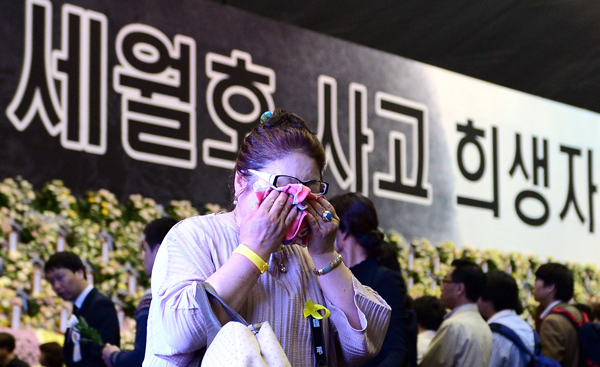The Sewol tragedy’s ‘forgetting curve’

An exhibition last week reminded me of the correlation between memory and repetition. Seochon Art Gallery in Hyoja-dong, Seoul, presented “Park Ye-seul, No. 17, Class 2-3 Danwon High School.” Eighty-five days after the Sewol ferry tragedy, most people are back to their routines and have gradually begun to forget the disaster. But the exhibition reminded Koreans to continue to mourn and pay attention to the event.
Park Ye-seul was one of the 293 people who died in the disaster. Her father cherished her artistic talent and had collected her artwork since her childhood. After the incident, he said in an interview that he would like to hold an exhibition for his daughter someday. The CEO of Seochon Gallery learned of the story and took on the initiative. “People say we must not forget, but I want to highlight what we should not forget and why. It is not the incident itself that’s so tragic. The dreams of Ye-seul and all the other victims have been crushed.”
Park, who aspired to become a designer, drew a pair of high heels, a matching outfit that she would like to wear with her future boyfriend, and the house, complete with a spacious living room, in which she would like to live. Korean artists got together and created models based on Park’s designs. The visitors were solemn and grieved the loss of the young souls. They included high school students who came after their final exams and mothers who have young children. Because the exhibition was publicized in the media and on social networks, an average of 1,000 people visited the gallery each day over the weekend. The line stretched out on the street on hot summer days, and messages in memory of the victims were posted in the gallery.
After the incident, we promised “not to forget.” University of Munich Professor Ulrich Beck, the author of “Risky Society,” warned of oblivion in his lecture on July 8. The Sewol ferry incident was an extraordinary disaster that enraged citizens, but society does not transform, or “verwandlung,” on its own, he said. It is important that reporters, other groups and citizens remember.
There is only one way not to forget. The key is constant reminder. Even before a national safety day is designated and a proper memorial park is established, we must constantly remember the victims through various events like the Park Ye-seul exhibition. The gallery will exhibit Park’s artworks indefinitely and would like to add more works of art from other victims, as well as collaborate with more artists and designers who support the cause. The forgetting curve of the Sewol ferry incident has to be different.
JoongAng Ilbo, July 10, Page 30
*The author is a reporter of the JoongAng Sunday.
BY LEE DO-EUN
전교 1등의 비법이 '철저한 복습'이라 하면 뻔한 것 같지만 일리가 있다. 독일의 심리학자 헤르만 에빙하우스의 '망각 곡선'이 그 근거다. 이론에 따르면 기억하려는 시도가 없다는 전제하에 인간은 평균적으로 1시간만 지나면 기억의 절반을 잊어버리고, 하루가 지나면 70%를, 한 달이 지나면 80%를 잊어버린단다. 중요한 건 이 'ㄴ'자 곡선이 그나마 완만해지기 위한 유일한 방법은 반복적인 학습뿐이라는 사실이다. 새삼 이 기억과 복습의 연관성을 떠올린 건 지난 주 한 전시를 찾아가서다. 서울 효자동 서촌갤러리에서 마련한 '단원고 2학년 3반 17번 박예슬 전시회’. 세월호 참사가 난 지 85일째로 접어들면서 이제 대다수가 일상으로 돌아가 사고를 조금씩 잊어가는 즈음, 이 전시가 사람들의 관심과 추모 열기를 다시 이끌고 있다. 예슬이는 사망자 293명 중 하나였다. 그림에 재능이 많았던 딸을 눈여겨 본 아버지는 예슬이가 어린 시절부터 그린 그림들을 모아 왔다. 사고 뒤 한 인터뷰에서 언젠가 전시회를 열어주고 싶다는 사연을 듣고 서촌갤러리 장영승 대표가 행사를 제안했다. "잊지 않겠다는데 도대체 무엇을, 왜 잊지 말아야하는지 말하고 싶었어요. 사고 그 자체가 아닙니다. 예슬이의 꿈, 아이들의 꿈이 멈췄다는 사실이죠." 디자이너가 되고 싶다던 아이는 굽이 독특한 하이힐을, 언젠가 남자친구와 맞춰 입고 싶다던 커플룩을, 언젠가 살고 싶은 거실이 넓은 집을 그렸다. 현업 디자이너들은 이를 바탕으로 실물도 제작했다. 현장에서 본 관람객들은 하나같이 숙연했다. 눈시울이 하나둘씩 붉어졌고, 누군가는 손수건을 꺼내들었다. 그 중엔 기말고사를 마치자마자 인천에서 달려 온 고3 여학생과 여고 동창 모임에서 함께 온 엄마들도 있었다. 이런 소식이 언론과 SNS로 퍼지면서 주말엔 하루 평균 1000명이 다녀갔다. 땡볕 골목길에 줄이 이어졌고, 갤러리 내부엔 추모의 메시지를 담은 메모장이 나붙었다. 사고 이후 우리가 약속한 건 '잊지 않겠다'였다. 8일 내한 강연한 『위험사회』의 저자이자 사회학자인 울리히 벡 뮌헨대 교수의 발언 역시 망각을 경계한다. “세월호 사고는 특별한 재앙이었고, 국민들의 분노를 불러일으켰다. 하지만 사회는 저절로 ‘탈바꿈(Verwandlung)'하지 않는다. 기자를 비롯한 여러 집단, 특히 시민들이 잊지 않는 것이 중요하다.” 이 명제를 실천하기 위해 필요한 건 하나다. 꾸준한 복기요, 복습뿐이다. 그래서 '국민 안전의 날'이 지정되고 번듯한 추모 공원이 설립되기 전이라도, 이번 전시처럼 그들을 떠올릴 수 있는 자리가 지속적으로 마련됐으면 싶다. 반갑게도 예슬이의 전시는 무기한이다. 갤러리 측은 다른 아이들의 그림을 더하고, 뜻을 같이하는 디자이너들과 협업을 진행하며 전시를 계속하겠다는 계획이다. 세월호의 망각 곡선이 그만큼 다르게 그려지고 있을 터다. 이도은 중앙SUNDAY 기자










with the Korea JoongAng Daily
To write comments, please log in to one of the accounts.
Standards Board Policy (0/250자)